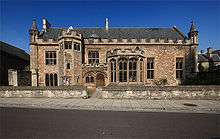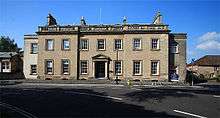Wells Theological College
Wells Theological College began operation in 1840 within the Cathedral Close of Wells Cathedral.[1] It was one of several new colleges created in the nineteenth century to cater not just for non-graduates, but for graduates from the old universities who wished to receive specialist clerical training in preparation for ordination into the Church of England.[2] It was founded by Bishop Law.[3]

In 1971 it merged with Salisbury Theological College, the students moved to Salisbury, and the new institution became known as the Salisbury & Wells Theological College, now Sarum College.
Education
The first principal of the college was John Hothersal Pinder who had held a similar position at Codrington College, Barbados.[4] He remained at Wells until about 1865 when he resigned on account of infirmity.[5] Under his leadership the college became known as a 'desirable place for training ordinands'. At the same time the college was criticised for its tractarian tendencies.[6]
In 1884 the tuition fees were £30 per annum, or £10 per term. There were lodgings for 30 students, and since its founding 898 students had been admitted. All except 30 had taken university degrees.[7] At that time graduates studied for one year, non-graduates for two. Their studies included Holy Scriptures, Book of Common Prayer, the Articles, ecclesiastical history, Hebrew and pastoral theology. They attended many chapel services and had the opportunity of performing parochial work. [8]
Buildings

A guide book of 1862 notes that the students were using the Vicars' Hall as a library,[9] but in 1896 they purchased a nearby building for this purpose on Cathedral Green. Rebuilt in the 15th century for Archdeacon Holes, it was still used as a house in 1555 when Bishop Polydore Vergil surrendered it to the Crown. In the late 18th century it became a brewery, but was extensively restored 1886. It is now a Grade II* Listed Building and is the Music School and Concert Hall of the Wells Cathedral School.[10][11]
The college acquired the lease of the chapel in Vicars' Close in 1875.[12] The Cedars, a house built in 1758 for MP Charles Tudway,[13] was leased by the Trustees of the Theological College in 1919 for use as a hostel for some of the students.[14]
Notable alumni
- Peter Ball, convicted sex offender and former bishop
- Henry Montgomery Campbell, bishop
- Douglas Russell Feaver
- Noel Debroy Jones
- Walter Kenrick Knight-Adkin
- Alfred Merle Norman
- Ronald Ragsdale Sargison
- J. Spencer Trimingham
- John Stevens Waller
Notable staff
- Edgar Charles Sumner Gibson, chaplain, then vice-principal.
- Christopher Hollis, vice-principal.
- George Arthur Hollis, principal.
- Gordon Mursell, tutor.
- Richard Godfrey Parsons, principal (1911–16).
- John Alexander Ramsbotham, vice-principal.
- John Robinson, chaplain (1948–51).
- Charles Williams, chaplain.
See also
References
- Burns, R. Arthur (1999). The diocesan revival in the Church of England, c. 1800–1870. Oxford University Press. p. 153. ISBN 978-0-19-820784-9. Retrieved 2 October 2009.
- Dowland, David A. (1997). Nineteenth-century Anglican Theological Training: The Redbrick Challenge. Clarendon Press. pp. 5–6. ISBN 9780198269298. Retrieved 7 October 2015.
- Kelly, Edward Robert (1875). Somersetshire. Oxford University. p. 502. Retrieved 7 October 2015.
- "Death of the Rev. Canon Pinder". Bath Chronicle and Weekly Gazette. 23 April 1868. Retrieved 7 October 2015 – via British Newspaper Archive.
- Mission Field: A Monthly Record of the Proceedings of the Society for the Propagation of the Gospel in Foreign Parts, Vol 13. 1868. p. 176. Retrieved 7 October 2015.
- Bateman, James (1853). The Tractarian Tendency of Diocesan Theological Colleges. A Speech, Etc. Seeleys. pp. 19–20. Retrieved 30 October 2015.
- The Official Year-book of the Church of England. Society for Promoting Christian Knowledge. 1884. pp. 12–13. Retrieved 7 October 2015.
- The official year-book of the Church of England. Society for Promoting Christian Knowledge. 1885. p. 5. Retrieved 2 October 2009.
Wells Theological College buildings.
- G, E (1862). The tourist's guide to Wells, the cathedral, Cheddar cliffs, &c. Oxford University. p. 57. Retrieved 7 October 2015.
- "THE MUSIC SCHOOL AND ATTACHED WALLS, CATHEDRAL GREEN". historicengland.org.uk. English Heritage. Retrieved 2 October 2009.
- "The Music School and attached walls". Somerset Historic Environment Record. Somerset County Council. 1997. Retrieved 2 October 2009.
- Clarke, John Erskine, ed. (8 May 1875). "Wells Theological College". Church Bells. V (228): 266. Retrieved 6 October 2015.
- "The Cedars". historicengland.org.uk. English Heritage. Retrieved 6 October 2015.
- "Opening of "The Cedars" as a Hostel". Wells Journal. 31 October 1919. Retrieved 6 October 2015 – via British Newspaper Archive.
Further reading
- The history of Wells Theological College, by Edward Leighton Elwes, Society for Promoting Christian Knowledge, 1923. 116 pages.
- The Diffusion of Tractarianism: Wells Theological College, 1840–49., Jacob, W. M., Southern History 5 (1983): 189–209.